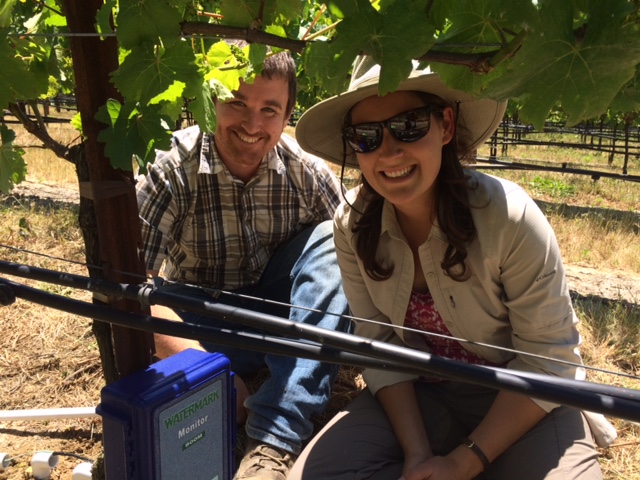Water conservation is at the forefront of our effort to farm in an environmentally sensitive manner. Last week, thanks to a generous gift from Fish Friendly Farming, we added another important tool to our water efficiency arsenal: a soil moisture sensor.
Fish Friendly Farming obtained a grant to make soil moisture sensors available to farmers in the Russian River and Navarro River watersheds. The sensors allow farmers to actually see below the soil surface to determine the water content of the soil. It thus provides additional data which is useful in determining when an irrigation is required and whether the amount of irrigation provided is the right amount. We applied for and were grateful to receive a soil sensor, which was installed by Melina and Cody.
We’ve traditionally used several technologies to insure that we give our vines the water they need when they need it and no more.
Drip irrigation: Our drip irrigation system and dual drip lines allow us to precisely meter water to plants that need it, while minimizing evaporative loss.
Leaf water potential: Using a “pressure bomb” (unfortunate name) allows us to determine the water status of individual plants. We use this data primarily to determine when to begin irrigation—we wait until the plants reach a predetermined level of water stress (i.e., we wait until they are thirsty) before starting irrigation. Secondarily, we use the data to monitor the effect of irrigations we make during the growing season.
California irrigation management information system (CIMIS) data: The CIMIS system is a network of climate sensors developed by the State of California and the University of California, Davis that allows farmers throughout the state to calculate how much water is lost by plants on a daily basis to evaporation and transpiration. Transpiration is the process where plants absorb water through their root system and respire it to the atmosphere through their leaves. The CIMIS data allows us to determine how much water we need to provide the vines to replace what they’ve lost.
Visual observation: You can also tell a lot about vine water status just by looking, if you know what to look for. These signs include shortened and sagging shoot tip tendrils, leaves turned away from the sun, leaf petioles sagging, and leaves in the fruiting zone starting to yellow.
One of the things that really encouraged me about working with Fish Friendly Farming is that it was an example of a member of the environmental community working with farmers in a constructive way to achieve a common goal: resource conservation.
Ask clay gantz, co-owner/grower
Why aren't more grapes "dry farmed" (grown without irrigation)?
After all, they dry farm in Europe, right? It is possible to dry farm grapes in some vineyards in California. However, in most it is not. The reason why they can in Europe, but not universally in California is simple: While in Northern California we actually get a little more annual rainfall (31.5 inches) than in Burgundy (30.5 inches), in Europe it consistently and regularly rains (about 2 inches a month) during the summer growing season. In Northern California, we get virtually no rain from May to October. The rain we get in the winter recharges our groundwater basins and is stored and used in summer when needed. This is why agricultural and other open space uses are so important—water that falls on a urban area is diverted from the groundwater basins and runs to the sea through storm drains.
Click below to learn more:




